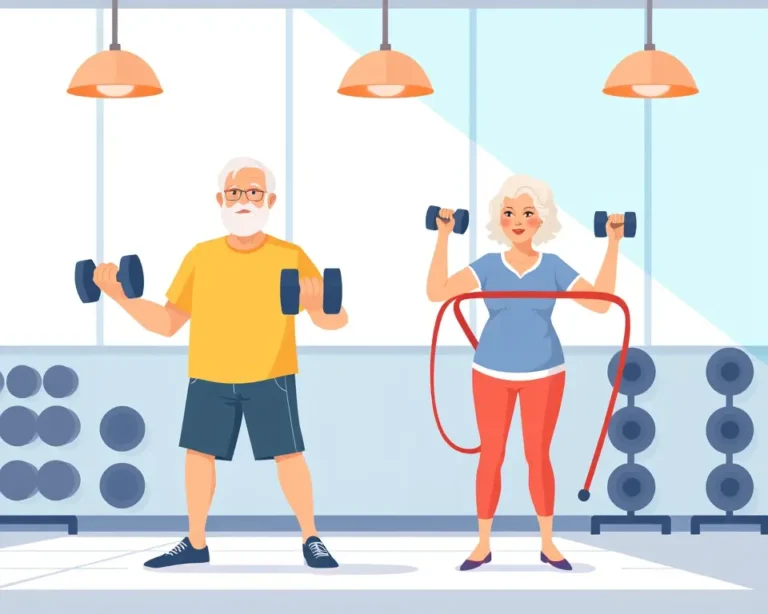As we gracefully advance in years, maintaining an active lifestyle becomes paramount. Many retirees are realizing that exercise is key to preserving independence and cherishing everyday moments. Studies show regular physical activity can drastically reduce the risk of falls, amplify energy levels, and sharpen cognitive function. But with countless fitness options available, what stands out as the most effective for those over 60? Experts are increasingly pointing toward strength training as the cornerstone of a well-rounded fitness regimen for this age group.
The Power of Strength Training
While activities like walking and running certainly have their benefits, strength training offers a unique advantage for retirees. It directly combats age-related muscle loss (sarcopenia), strengthens bones, and makes everyday tasks significantly easier.
Why Strength Training Reigns Supreme
- Preserves Muscle Mass: As we age, we naturally lose muscle mass, which can lead to weakness and reduced mobility. Strength training helps to maintain and even rebuild muscle, improving overall strength and function.
- Strengthens Bones: Weight-bearing exercises are crucial for bone density. Strength training helps to prevent osteoporosis and reduces the risk of fractures.
- Enhances Daily Life: Strength training makes everyday activities, such as carrying groceries, climbing stairs, and gardening, much easier and safer.
- Boosts Metabolism: Muscle tissue burns more calories than fat tissue. By increasing muscle mass, strength training can help boost metabolism and manage weight.
- Improves Balance and Stability: Many strength training exercises improve balance and coordination, which is essential for preventing falls, a major concern for older adults.
- Lifts Mood and Cognitive Function: Physical activity, including strength training, has been shown to improve mood, reduce stress, and enhance cognitive function.
- Manages Chronic Conditions: Strength training can help manage symptoms of chronic conditions such as arthritis, type 2 diabetes, and heart disease.
Getting Started with Strength Training
The beauty of strength training is its adaptability. Simple routines using dumbbells, resistance bands, or even bodyweight exercises can yield remarkable results.
Sample Exercises for Beginners
- Seated Bicep Curls: Using light dumbbells, sit in a chair with your feet flat on the floor. Curl the weights up towards your shoulders, then slowly lower them back down. This exercise builds upper body strength for carrying and lifting.
- Wall Push-Ups: Stand facing a wall, place your hands shoulder-width apart on the wall, and lean in until your chest touches the wall. Push back to the starting position. This exercise strengthens the upper body without straining the wrists or shoulders.
- Ankle-Weighted Leg Lifts: Sit in a chair with ankle weights attached. Lift one leg straight out in front of you, hold for a few seconds, and then slowly lower it back down. This exercise improves leg strength and stability, reducing the risk of falls.
- Chair Squats: Stand in front of a chair with your feet shoulder-width apart. Lower yourself down as if you are going to sit, but stop just before your bottom touches the chair. Stand back up. This exercise strengthens the legs and glutes, improving overall lower body strength.
- Overhead Press: Seated or standing, use light dumbbells to press overhead, extending your arms straight up. This exercise works the shoulders and upper back, improving posture and upper body strength.
- Calf Raises: Stand behind a chair or counter for support. Rise up onto your toes, hold for a second, and then slowly lower back down. This exercise strengthens the calf muscles, which are important for balance and walking.
- Resistance Band Rows: Sit in a chair with your feet flat on the floor. Place a resistance band around your feet and hold the ends with your hands. Pull the band towards your chest, squeezing your shoulder blades together. This exercise strengthens the back muscles, improving posture and balance.
Tips for Safe and Effective Strength Training
- Consult a Doctor: Before starting any new exercise program, especially if you have any underlying health conditions, consult your doctor.
- Start Slowly: Begin with light weights or resistance and gradually increase the intensity as you get stronger.
- Focus on Form: Proper form is crucial to prevent injuries. If you’re unsure about proper technique, consider working with a certified personal trainer.
- Warm-Up: Before each workout, warm up with light cardio and dynamic stretching.
- Cool Down: After each workout, cool down with static stretching, holding each stretch for 20-30 seconds.
- Listen to Your Body: Rest when you need to, and don’t push yourself too hard, especially when you’re just starting out.
- Stay Consistent: Aim for at least two strength training sessions per week for optimal results.
- Breathe: Exhale during the exertion phase of each exercise and inhale during the relaxation phase.
- Stay Hydrated: Drink plenty of water before, during, and after your workouts.
Beyond Strength Training: A Holistic Approach
While strength training is a cornerstone, a well-rounded fitness routine for retirees should also incorporate other forms of exercise.
Complementary Activities
- Chair Yoga: This gentle form of yoga enhances flexibility, balance, and eases muscle tension. It’s accessible for individuals with limited mobility or balance issues. The stretches and poses improve joint health and muscle strength.
- Swimming and Water Aerobics: Water workouts are gentle on the joints while providing a full-body workout. The buoyancy of water reduces stress on the body, making it ideal for those with arthritis or other joint issues. Water aerobics improves strength, flexibility, and balance with minimal impact.
- Cycling: A low-impact cardiovascular workout that is easy on the joints, making it ideal for older adults who may have arthritis or other joint issues. Regular cycling helps improve cardiovascular health, increase muscle strength, and enhance flexibility and balance, which can reduce the risk of falls.
- Balance Exercises: Incorporate exercises like standing on one foot or heel-to-toe walking to improve stability and prevent falls.
- Single Limb Stance: Stand behind a sturdy chair and hold on to the back of it. Lift up your right foot and balance on your left foot. Hold that position for as long as you can, then switch feet. The goal should be to stand on one foot without holding onto the chair and hold that pose for up to a minute.
- Feet Apart: Stand with feet about shoulder-width apart, eyes open, and hold steady for 10 seconds, working your way up to 30 seconds.
- Feet Together: Stand with feet together, eyes open, and hold steady 10 seconds, working your way up to 30 seconds.
- Sideways Walking: A man standing with feet together, then feet apart after stepping sideways with one foot
- Simple Grapevine
- Heel-to-Toe Walk: Lift your arms out to your sides and begin with one hand against a wall for support. Put your right foot in front of your left, so heel is pressed against toe. Then bring your left foot in front of your right, again pressing heel to toe. Continue walking forward this way.
- One-Leg Stand
- Step-Up
- Walking: A simple yet effective way to improve cardiovascular health and overall fitness. Aim for at least 150 minutes of moderate-intensity activity per week, such as brisk walking.
Staying Motivated and Engaged
- Find a Workout Buddy: Exercising with a friend or family member can help you stay motivated and accountable.
- Join a Class: Many senior centers and gyms offer guided classes focused on safe and effective exercises for older adults.
- Set Realistic Goals: Start with small, achievable goals and gradually increase the intensity and duration of your workouts.
- Track Your Progress: Monitoring your progress can help you stay motivated and see how far you’ve come.
- Reward Yourself: Celebrate your successes and milestones to stay engaged and enthusiastic.
- Make it Fun: Choose activities that you enjoy and that fit your lifestyle.
- Listen to Music: Upbeat music can help you stay energized and motivated during your workouts.
- Vary Your Routine: Mix up your workouts to prevent boredom and challenge different muscle groups.
A Stronger, Healthier You
Strength training offers a powerful pathway to a vibrant and fulfilling retirement. By preserving muscle mass, strengthening bones, and enhancing daily life, it empowers retirees to maintain their independence, enjoy their favorite activities, and embrace a healthier, more active lifestyle. Incorporate strength training into a holistic fitness routine, and unlock a world of possibilities in your golden years.







